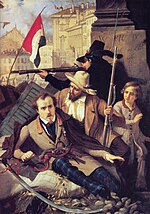United Provinces of Central Italy
United Provinces of Central Italy Province Unite del Centro Italia (Italian) | |||||||||||||||
|---|---|---|---|---|---|---|---|---|---|---|---|---|---|---|---|
| 1859–1860 | |||||||||||||||
 Coat of arms | |||||||||||||||
 The United Provinces of Central Italy (green) | |||||||||||||||
| Status | Client state of the Kingdom of Sardinia | ||||||||||||||
| Capital | Modena | ||||||||||||||
| Common languages |
| ||||||||||||||
| Government | Military government | ||||||||||||||
• King | Victor Emmanuel II | ||||||||||||||
• Governor General | Carlo Bon Compagni di Mombello | ||||||||||||||
• Appointed Regent | Eugenio Emanuele di Savoia-Carignano | ||||||||||||||
| Historical era | Late modern | ||||||||||||||
• Revolution | 8 December 1859 | ||||||||||||||
• Annexation | 22 March 1860 | ||||||||||||||
| Currency | Sardinian lira, Tuscan florin | ||||||||||||||
| |||||||||||||||
| Today part of | Italy | ||||||||||||||
The United Provinces of Central Italy (Italian: Province Unite del Centro Italia), also known as the Confederation of Central Italy or General Government of Central Italy, was a short-lived military government established by the Kingdom of Piedmont-Sardinia. It was formed by a union of the former Grand Duchy of Tuscany, Duchy of Parma, Duchy of Modena, and the Papal Legations, after the Second Italian War of Independence.
After August 1859, the pro-Piedmontese regimes of Tuscany, Parma, Modena and the Papal Legations agreed to several military treaties. On 7 November 1859, they elected Eugenio Emanuele di Savoia-Carignano [it] as their regent.
The peace of the Treaty of Zürich had left the question of the United Provinces unsettled.[1] This led to a period of negotiations and eventually to the Treaty of Turin during Napoleon III faced pressure from Austria through their ambassador Richard von Metternich to halt Sardinian expansion[2] and restore Ferdinand IV who had been deposed as Grand Duke of Tuscany and was a cousin of Austrian emperor Franz Joseph I.[2] The Austrians saw Savoia-Carignano, a member of the same dynasty as Victor Emmanuel II, as unacceptably likely to promote annexation by Sardinia.[3] At the urging of Napoleon III, Victor Emmanuel II refused to allow Savoia-Cariagnano to accept,[3] instead sending Carlo Bon Compagni[4] as the Governor General of Central Italy, who was responsible for the diplomatic and military affairs of the states.
On 8 December 1859, Parma, Modena and the Papal Legations were incorporated into the Royal Provinces of Emilia. After plebiscites were held during March 1860, and France was granted Nice and Savoy, the territory was annexed formally to Piedmont-Sardinia, as Bon Compagni resigned on 3 March 1860.
See also
- Italian Unification
- Grand Duchy of Tuscany
- Duchy of Parma
- Duchy of Modena and Reggio
- Victor Emmanuel II, King of Sardinia
- List of historical states of Italy
- Former countries in Europe after 1815
References
- Barker, Nancy Nichols (1967). Distaff Diplomacy. University of Texas Press. LCCN 67-30910.
- States and Regents of the World
- v
- t
- e
- Roman Kingdom (753 BC–509 BC)
- Roman Republic (509 BC–27 BC)
- Roman Empire (27 BC–395 AD)
- Western Roman Empire (395–476 AD)
and
Early Modern
states
and Napoleonic eras
(1792–1815)
| Republics | |
|---|---|
| Monarchies |
states
- Duchy of Genoa (1815–1848)
- Duchy of Lucca (1815–1847)
- Duchy of Massa and Carrara (1814–1829)
- Duchy of Modena and Reggio (1814–1859)
- Duchy of Parma and Piacenza (1814–1859)
- Grand Duchy of Tuscany (1815–1859)
- Italian United Provinces (1831)
- Provisional Government of Milan (1848)
- Republic of San Marco (1848–1849)
- Roman Republic (1849–1850)
- United Provinces of Central Italy (1859–1860)
- Kingdom of Sardinia (1814–1860)
- Kingdom of the Two Sicilies (1816–1861)
- Kingdom of Lombardy–Venetia (1815–1866)
- Papal States (1814–1870)
| Post-unification |
|
|---|
  | This Italian history article is a stub. You can help Wikipedia by expanding it. |
- v
- t
- e
- ^ Barker 1967, p. 49.
- ^ a b Barker 1967, p. 49–59.
- ^ a b Barker 1967, p. 58.
- ^ Barker 1967, p. 58–5 9.

















